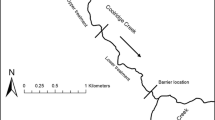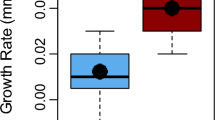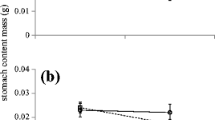Abstract
Invasive species are a leading cause for native species declines, yet it remains unclear whether maintenance of high native densities influence native persistence in freshwater systems. We designed complementary laboratory and field experiments to test whether high native cutthroat trout (Oncorhynchus clarkii) densities affect competition with invasive brown trout (Salmo trutta). We manipulated density of native cutthroat trout while holding brown trout density constant. Interspecific aggressive interactions towards native cutthroat trout were 66% fewer in the highest cutthroat trout density treatment compared to the lowest density treatment. At high densities of conspecifics, cutthroat trout, sympatric with brown trout, lost 33–81% less weight and demonstrated 1.5 times greater survival in both experiments than at low conspecific densities. Cutthroat trout held at low densities in laboratory experiments experienced greater stress-related disease virulence and negative effects of harassment, apparently owing to more frequent aggressive interactions with brown trout. These results support the hypothesis that reduced per capita effects of invaders on native fish at high densities buffers native species from negative effects of invaders, reducing the potential for invasive fish to displace high density native fish populations.




Similar content being viewed by others
Data availability
The data that support the findings of this study are available from the corresponding author upon reasonable request.
References
Al-Chokhachy R, Lien M, Shepard BB, High B (2021) The interactive effects of stream temperature, stream size, and non-native species on Yellowstone cutthroat trout. Can J Fish Aquat Sci Just-IN. https://doi.org/10.1139/cjfas-2020-0408
Bates D, Maechler M, Bolker B, Walker S (2015) Fitting linear mixed effects models using lme4. J Stat Softw 67:1–48. https://doi.org/10.18637/jss.v067.i01
Baxter CV, Fausch KD, Murakami M, Chapman PL (2004) Fish invasion restructures stream and forest food webs by interrupting reciprocal prey subsidies. Ecology 85:2656–2663. https://doi.org/10.1890/04-138
Benjamin JR, Baxter CV (2012) Is a trout a trout? A range-wide comparison shows nonnative brook trout exhibit greater density, biomass, and production than native inland cutthroat trout. Biol Inv 14:1865–1879. https://doi.org/10.1007/s10530-012-0198-9
Bradley BA, Laginhas BB, Whitlock R, Allen JM, Bates AE, Bernatchez G, Diez JM, Early R, Lenoir J, Vilà M, Sorte CJB (2019) Disentangling the abundance-impact relationship for invasive species. Proc Natl Acad Sci U S A 116:9919–9924. https://doi.org/10.1073/pnas.1818081116
Brown JH, Kodric-Brown A (1977) Turnover rates in insular biogeography: effects of immigration on extinction. Ecology 58:445–449. https://doi.org/10.2307/1935620
Budy P, Gaeta JW (2018) Brown trout as an invader: A synthesis of problems and perspectives in North America. In: Lobón-Cerviá J, Sanz N (eds) Brown trout: biology, ecology, and management, 1st edn. Wiley, New York, pp 525–543
Budy P, Thiede G, McHugh P (2007) Quantification of the vital rates, abundance, and status of a critical, endemic population of Bonneville cutthroat trout. N Am J Fish Manag 27:593–604. https://doi.org/10.1577/M06-085.1
Budy P, Thiede GP, McHugh P, Hansen ES, Wood J (2008) Exploring the relative influence of biotic interactions and environmental conditions on the abundance and distribution of exotic brown trout (Salmo trutta) in a high mountain stream. Ecol Freshw Fish 17:554–566. https://doi.org/10.1111/j.1600-0633.2008.00306.x
Budy P, Thiede GP, Lobón-Cerviá J, Fernandez GG, McHugh P, McIntosh A, Vøllestad LA, Becares E, Jellyman P (2013) Limitation and facilitation of one of the world’s most invasive fish: an intercontinental comparison. Ecology 94:356–367. https://doi.org/10.1890/12-0628.1
Budy P, Rogers KB, Kanno Y, Penaluna BE, Hitt NP, Thiede GP, Dunham J, Mellison C, Somer WL, DeRito J (2019) Distribution and status of trout and char in North America. In: Kershner JL, Williams JE, Gresswell RE, Lobón-Cerviá J (eds) Trout and char of the world. American Fisheries Society, Bethesda, pp 193–250
Budy PE, Walsworth T, Thiede GP, Thompson PD, McKell MD, Holden PB, Chase PD, Saunders WC (2021) Resilient and rapid recovery of native trout after removal of a non-native trout. Conserv Sci Pract 3:e325. https://doi.org/10.1111/csp2.325
Bullock GL, Hsu TC, Shotts EBJ (1986) Columnaris disease of fishes. Fish Disease Leaflet. U.S. Fish and Wildlife Service, Washington, DC.
Cheng BS, Hovel KA (2010) Biotic resistance to invasion along an estuarine gradient. Oecologia 164:1049–1059. https://doi.org/10.1007/s00442-010-1700-7
Cooper SD, Walde SJ, Peckarsky BL (1990) Prey exchange rates and the impacts of predators on prey populations in streams. Ecology 71:1503–1514. https://doi.org/10.2307/1938287
Cucherousset J, Olden JD (2011) Ecological impacts of nonnative freshwater fishes. Fisheries 36:215–230. https://doi.org/10.1080/03632415.2011.574578
de la Hoz Franco EA, Budy P (2005) Effects of biotic and abiotic factors on the distribution of trout and salmon along a longitudinal stream gradient. Environ Biol Fish 72:379–391. https://doi.org/10.1007/s10641-004-2591-4
Deslauriers D, Chipps SR, Breck JE, Rice JA, Madenjian CP (2017) Fish bioenergetics 4.0: an R-based modeling application. Fisheries 42:586–596. https://doi.org/10.1080/03632415.2017.1377558
Dunham JB, Rieman BE (1999) Metapopulation structure of bull trout: influences of physical, biotic, and geometrical landscape characteristics. Ecol Appl 9:642–655. https://doi.org/10.1890/1051-0761(1999)009[0642:MSOBTI]2.0.CO;2
Dunham JB, Adams SB, Schroeter RE, Novinger DC (2002) Alien invasions in aquatic ecosystems: toward an understanding of brook trout invasions and potential impacts on inland cutthroat trout in western North America. Rev Fish Biol Fish 12:373–391. https://doi.org/10.1023/a:1025338203702
Elliott JM (1994) Quantitative ecology and the brown trout. Oxford University Press
Elton CS (1958) The ecology of invasions by animals and plants. Wiley, New York
Fausch KD (1984) Profitable stream positions for salmonids: relating specific growth rate to net energy gain. Can J Zoo 62:441–451. https://doi.org/10.1139/z84-067
Fausch KD (1998) Interspecific competition and juvenile Atlantic salmon (Salmo salar): on testing the effects and evaluating the evidence across scales. Can J Fish Aquat Sci 55:218–231. https://doi.org/10.1139/d98-006
Fausch KD (2007) Introduction, establishment and effects of non-native salmonids: considering the risk of rainbow trout invasion in the United Kingdom. J Fish Biol 71:1–32. https://doi.org/10.1111/j.1095-8649.2007.01682.x
Fausch KD, Torgersen CE, Baxter CV, Li HW (2002) Landscapes to riverscapes: bridging the gap between research and conservation of stream fishes. Bioscience 52:483–498. https://doi.org/10.1641/0006-3568(2002)052[0483:LTRBTG]2.0.CO;2
Fox J, Weisberg S (2019) An R companion to applied regression, 2nd edn. Sage, Thousand Oaks
Fridley JD (2011) Biodiversity as a bulwark against invasion: conceptual threads since Elton. In: Richardson DM (ed) The legacy of charles elton. Wiley-Blackwell, Oxford, pp 121–130
Grossman GD, Simon TN (2020) Density-dependent effects on salmonid populations: a review. Ecol Freshw Fish 29:400–418. https://doi.org/10.1111/eff.12523
Gunckel SL, Hemmingsen AR, Li JL (2002) Effect of bull trout and brook trout interactions on foraging habitat, feeding behavior, and growth. Trans Am Fish Soc 131:1119–1130. https://doi.org/10.1577/1548-8659(2002)131%3c1119:EOBTAB%3e2.0.CO;2
Harvey BC, White JL, Nakamoto RJ (2005) Habitat-specific biomass, survival, and growth of rainbow trout (Oncorhynchus mykiss) during summer in a small coastal stream. Can J Fish Aquat Sci 62:650–658. https://doi.org/10.1139/f04-225
Hasegawa K, Maekawa K (2008) Potential of habitat complexity for mitigating interference competition between native and non-native salmonid species. Can J Fish Aquat Sci 86:386–393. https://doi.org/10.1139/Z08-015
Hudina S, Hock K, žganec K, (2014) The role of aggression in range expansion and biological invasions. Curr Zoo 60:401–409. https://doi.org/10.1093/czoolo/60.3.401
Imre I, Grant JW, Cunjak RA (2005) Density-dependent growth of young-of-the-year Atlantic Salmon Salmo salar in Catamaran Brook, New Brunswick. J Anim Ecol 74:508–516. https://doi.org/10.1111/j.1365-2656.2005.00949.x
Jackson MC, Ruiz-Navarro A, Britton JR (2015) Population density modifies the ecological impacts of invasive species. Oikos 124:880–887. https://doi.org/10.1111/oik.01661
Johnsson JI, Åkerman A (1998) Watch and learn: preview of the fighting ability of opponents alters contest behaviour in rainbow trout. Anim Behav 56:771–776. https://doi.org/10.1006/anbe.1998.0824
Juette T, Cucherousset J, Cote J (2014) Animal personality and the ecological impacts of freshwater non-native species. Curr Zool 60:417–427. https://doi.org/10.1093/czoolo/60.3.417
Kornis MS, Carlson J, Lehrer-Brey G, Vander Zanden MJ (2014) Experimental evidence that ecological effects of an invasive fish are reduced at high densities. Oecologia 175:325–334. https://doi.org/10.1007/s00442-014-2899-5
Lefcheck S (2016) piecewiseSEM: piecewise structural equation modeling in R for ecology, evolution, and systematics. Methods Ecol Evo 7:573–579. https://doi.org/10.1111/2041-210X.12512
Lesica P, Allendorf FW (1995) When are peripheral-populations valuable for conservation? Conserv Biol 9:753–760. https://doi.org/10.1046/j.1523-1739.1995.09040753.x
Levine JM, Adler PB, Yelenik SG (2004) A meta-analysis of biotic resistance to exotic plant invasions. Ecol Lett 7:975–989. https://doi.org/10.1111/j.1461-0248.2004.00657.x
McHugh P, Budy P (2005) An experimental evaluation of competitive and thermal effects on brown trout (Salmo trutta) and Bonneville cutthroat trout (Oncorhynchus clarkii utah) performance along an altitudinal gradient. Can J Fish Aquat Sci 62:2784–2795. https://doi.org/10.1139/f05-184
McHugh P, Budy P (2006) Experimental effects of nonnative brown trout on the individual- and population-level performance of native Bonneville cutthroat trout. Trans Am Fish Soc 135:1441–1455. https://doi.org/10.1577/T05-309.1
McIntosh A, McHugh P, Budy P (2012) Salmo trutta L. (brown trout). In: Francis RA (ed) A handbook of global freshwater invasive species. Taylor and Francis, London, pp 285–296
Meredith C (2012) Effects of a changing physical template on the longitudinal distribution of brown trout in a mountain stream: implications for brown trout invasion success. Dissertation, Utah State University
Meredith C, Budy P, Hooten MB, Prates MO (2017) Assessing conditions influencing the longitudinal distribution of exotic brown trout (Salmo trutta) in a mountain stream: a spatially-explicit modeling approach. Biol Inv 19:503–519. https://doi.org/10.1007/s10530-016-1322-z
Morita K, Yamamoto S (2002) Effects of habitat fragmentation by damming on the persistence of stream-dwelling charr populations. Conserv Biol 16:1318–1323. https://doi.org/10.1046/j.1523-1739.2002.01476.x
Nakagawa S, Johnson PCD, Schielzeth H (2017) The coefficient of determination R2 and intra-class correlation coefficient from generalized linear mixed-effects models revisited and expanded. J R Soc Interface 14:20170213. https://doi.org/10.1098/rsif.2017.0213
Pennock CA, Durst SL, Duran BR, Hines BA, Cathcart CN, Davis JE, Schleicher BJ, Franssen NR (2018) Predicted and observed responses of a nonnative Channel Catfish population following managed removal to aid the recovery of endangered fishes. N Am J Fish Manag 38:565–578. https://doi.org/10.1002/nafm.10056
Pintor LM, Sih A, Bauer ML (2008) Differences in aggression, activity and boldness between native and introduced populations of an invasive crayfish. Oikos 117:1629–1636. https://doi.org/10.1111/j.1600-0706.2008.16578.x
Puth LM, Post DM (2005) Studying invasion: Have we missed the boat? Ecol Lett 8:715–721. https://doi.org/10.1111/j.1461-0248.2005.00774.x
Pyšek P, Hulme PE, Simberloff D, Bacher S, Blackburn TM, Carlton JT, Dawson W, Essl F, Foxcroft LC, Genovesi P, Jeschke JM, Kühn I, Liebhold AM, Mandrak NE, Meyerson LA, Pauchard A, Pergl J, Roy HE, Seebens H, van Kleunen M, Vila M, Wingfield MJ, Richardson DM (2020) Scientists’ warning on invasive alien species. Biol Rev 95:1511–1534. https://doi.org/10.1111/brv.12627
R Core Team (2020) R: a language and environment for statistical computing. R Foundation for Statistical Computing, Vienna. https://www.R-project.org/
Roberts JJ, Fausch KD, Hooten MB, Peterson DP (2017) Nonnative trout invasion combined with climate change threaten persistence of isolated cutthroat trout populations in the southern Rocky Mountains. N Am J Fish Manag 37:314–325. https://doi.org/10.1080/02755947.2016.1264507
Sanders NJ, Gotelli NJ, Heller NE, Gordon DM (2003) Community disassembly by an invasive species. Proc Natl Acad Sci U S A 100:2474–2477. https://doi.org/10.1073/pnas.0437913100
Sanderson EW (2006) How many animals do we want to save? The many ways of setting population target levels for conservation. Bioscience 56:911–922. https://doi.org/10.1641/0006-3568(2006)56[911:HMADWW]2.0.CO;2
Saunders WC, Budy P, Thiede GP (2015) Demographic changes following mechanical removal of exotic brown trout in an Intermountain West (USA), high-elevation stream. Ecol Freshw Fish 24:252–263. https://doi.org/10.1111/eff.12143
Shaffer ML (1981) Minimum population sizes for species conservation. Bioscience 31:131–134
Sinclair ARE, Byrom AE (2006) Understanding ecosystem dynamics for conservation of biota. J Anim Ecol 75:64–79. https://doi.org/10.1111/j.1365-2656.2006.01036.x
South J, Madzivanzira TC, Tshali N, Measey J, Weyl OLF (2020) In a pinch: Mechanisms behind potential biotic resistance toward two invasive crayfish by native African freshwater crabs. Front Ecol Evo 8:72. https://doi.org/10.3389/fevo.2020.00072
Strange EM, Moyle PB, Foin TC (1993) Interactions between stochastic and deterministic processes in stream fish community assembly. Environ Biol Fish 36:1–15. https://doi.org/10.1007/bf00005973
Tattam IA (2006) Seasonal life history of Oncorhynchus mykiss in the south fork John Day River Basin, Oregon. Thesis, Oregon State University
Tattam IA, Li HW, Giannico GR, Ruzycki JR (2017) Seasonal change in spatial patterns of Oncorhynchus mykiss growth require year-round monitoring. Ecol Freshw Fish 26:434–443. https://doi.org/10.1111/eff.12287
Theoharides KA, Dukes JS (2007) Plant invasion across space and time: factors affecting nonindigenous species success during four stages of invasion. New Phytol 176:256–273. https://doi.org/10.1111/j.1469-8137.2007.02207.x
Underwood AJ (2012) Experiments in ecology: their logical design and interpretation using analysis of variance. Cambridge University Press, New York
Uthe P, Al-Chokhachy R, Shepard BB, Zale AV, Kershner JL (2019) Effects of climate-related stream factors on patterns of individual summer growth of cutthroat trout. Trans Am Fish Soc 148:21–34. https://doi.org/10.1002/tafs.10106
Von Holle B, Simberloff D (2005) Ecological resistance to biological invasion overwhelmed by propagule pressure. Ecology 86:3212–3218. https://doi.org/10.1890/05-0427
Wakabayashi H (1991) Effect of environmental-conditions on the infectivity of flexibacter-columnaris to fish. J Fish Dis 14:279–290. https://doi.org/10.1111/j.1365-2761.1991.tb00825.x
Wenger SJ, Isaak DJ, Dunham JB, Fausch KD, Luce CH, Neville HM, Rieman BE, Young MK, Nagel DE, Horan DL, Chandler GL (2011) Role of climate and invasive species in structuring trout distributions in the interior Columbia River Basin, USA. Can J Fish Aquat Sci 68:988–1008. https://doi.org/10.1139/f2011-034
Williams JE, Haak AL, Neville HM, Colyer WT (2011) Potential consequences of climate change to persistence of cutthroat trout populations. N Am J Fish Manag 29:533–548. https://doi.org/10.1577/M08-072.1
Wolf S, Hartl B, Carroll C, Neel MC, Greenwald DN (2015) Beyond PVA: Why recovery under the Endangered Species Act is more than population viability. Bioscience 65:200–207. https://doi.org/10.1093/biosci/biu218
Wood J, Budy P (2009) The role of environmental factors in determining early survival and invasion success of exotic brown trout. Trans Am Fish Soc 138:756–767. https://doi.org/10.1577/T08-123.1
Wood CM, Kryshak N, Gustafson M, Hofstadter DF, Hobart BK, Whitmore SA, Dotters BP, Roberts KN, Keane JJ, Sawyer SC, Gutierrez RJ, Peery MZ (2021) Density dependence influences competition and hybridization at an invasion front. Divers Distrib 00:1–12. https://doi.org/10.1111/ddi.13240
Xu C, Letcher BH, Nislow KH (2010) Context-specific influence of water temperature on brook trout growth rates in the field. Freshw Biol 55:2253–2264. https://doi.org/10.1111/j.1365-2427.2010.02430.x
Young MK (1995) Conservation assessment for inland cutthroat trout. General Technical Report RM-256. U.S. Department of Agriculture, Forest Service, Rocky Mountain Forest and Range Experiment Station, Fort Collins, CO
Zenni RD, Sampaio AB, Lima YP, Pessoa-Filho M, Lins TCL, Pivello VR, Daehler C (2019) Invasive Melinis miutiflora outperforms native species, but the magnitude of the effect is context-dependent. Biol Inv 21:657–667. https://doi.org/10.1007/s10530-018-1854-5
Acknowledgements
We thank Jared Baker (posthumous), Tracy Bowerman, Wes Gordon, Nick Heredia, Kyle Hillman, Paul Holden, Stephen Klobucar, Noah Kuhns, Peter MacKinnon, Christy Meredith, Sam Mckay, Hannah Moore, Bryce Rolholt, Tim Walsworth, Lisa Winters, and Todd Wright for assistance in the field and laboratory. We thank Gary Thiede, Paul Burnett, Clay Perschon, Craig Schaugaard, Paul Thompson, Craig Walker, Chris Wilson and the Utah Division of Wildlife Resources Fisheries Experiment Station (UDWR), and Paul Chase for providing assistance and support. Previous drafts of this manuscript were greatly improved by comments from Jeff Falke, Kurt Fausch, Brett Roper, Garrett Hopper, Peter Adler, Jason Dunham, and two anonymous reviewers. Any use of trade, firm, or product names is for descriptive purposes only and does not imply endorsement by the U. S. Government. This study was performed under the auspices of the USU IACUC Protocol Number 1390 and state COR Permit Number 2COLL5415.
Funding
Primary funding was provided by the U. S. Geological Survey (Cooperative Agreement No. G10AC00507) and UDWR Endangered Species Mitigation and Blue Ribbon Fishery Funds. Additional funding was provided by the U. S. Forest Service, U. S. Geological Survey, Utah Cooperative Fish and Wildlife Research Unit at Utah State University (in-kind; USU), the Intermountain Center for River Rehabilitation and Restoration at USU, and Cache Anglers Chapter of Trout Unlimited.
Author information
Authors and Affiliations
Contributions
WCS and PB designed and conducted the experiments. CAP analyzed the data and drafted the manuscript with input from WCS and PB.
Corresponding author
Ethics declarations
Conflict of interest
The authors declare no conflicts of interest.
Additional information
Publisher's Note
Springer Nature remains neutral with regard to jurisdictional claims in published maps and institutional affiliations.
Rights and permissions
About this article
Cite this article
Pennock, C.A., Carl Saunders, W. & Budy, P. High densities of conspecifics buffer native fish from negative interactions with an ecologically similar invasive. Biol Invasions 24, 1283–1297 (2022). https://doi.org/10.1007/s10530-021-02725-y
Received:
Accepted:
Published:
Issue Date:
DOI: https://doi.org/10.1007/s10530-021-02725-y




